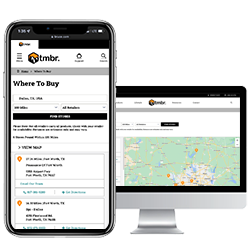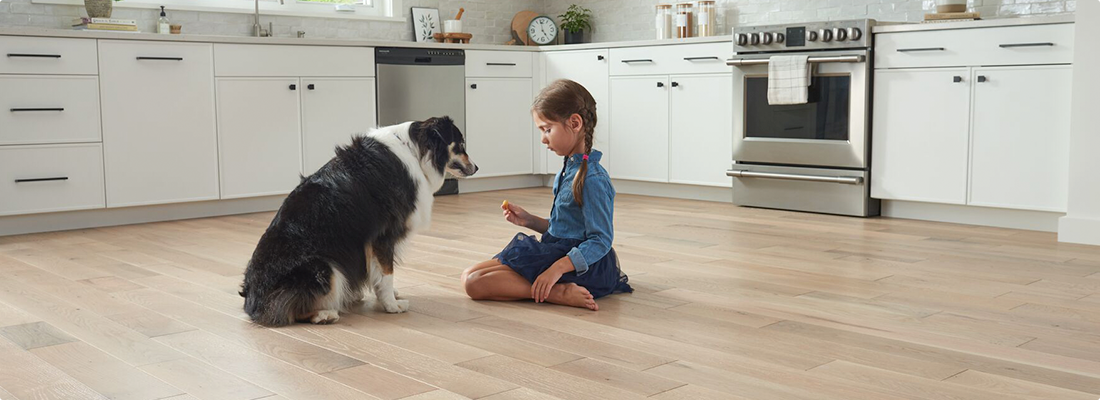Healthy Flooring Choices
If you suffer from allergies or asthma, focusing on healthy flooring choices is essential. Fortunately, engineered hardwood meets all the criteria.
December 21, 2023 | By tmbr Product Expert
Are you or someone in your family dealing with allergies? Allergies can make daily life challenging.
When you think of allergies, the first that come to mind are food and pollen allergies. Common food allergies include dairy and peanuts. And sneezing and runny noses are common in spring when pollen counts rise.
But did you know that one unexpected source of irritation might be your flooring? Your floors can harbor dust, mold, pollen, pet dander, and more.
Choosing healthy flooring materials can substantially affect indoor air quality and overall comfort.
Allergies are Common in the U.S.
According to the Centers for Disease Control (CDC), nearly one-third of adults and one-quarter of children have allergies. More than 25% of adults suffer seasonal allergies, while almost 19% of children have the same.
In sum, over 50 million people experience allergies every year. That makes it the sixth most common cause of chronic illness in the U.S.
Common Allergens Your Floors Harbor
Allergens are substances that can trigger allergic reactions in sensitive individuals. Several common allergens can accumulate in your flooring and become problematic for allergy sufferers:
-
Dust Mites: Dust mites are tiny creatures that thrive in warm and humid environments. They feed on dead skin cells and can easily make their homes in carpets and rugs. Dust mite droppings contain allergenic proteins that can trigger allergic reactions.
-
Pet Dander: If you have furry friends at home, you’re likely dealing with pet dander. These small, airborne particles of skin, hair, and saliva from pets can settle into carpets and upholstery.
-
Pollen: You can readily track pollen from outdoor plants indoors on shoes and clothing. Once indoors, it can settle into carpet fibers and other flooring materials. That becomes a nuisance for those sensitive to pollen.
-
Mold: Mold spores thrive in damp environments. They can grow on or beneath flooring materials like carpet, especially in areas prone to moisture buildup. Inhaling mold spores can lead to allergic reactions and breathing problems.
-
Insects: Insects, such as cockroaches, can leave behind allergenic proteins in their droppings. Flooring materials like carpeting can trap these proteins and trigger allergic reactions.
Characteristics of Healthy Flooring Materials
You can create a more healthy environment indoors with healthy flooring choices. The best flooring for allergies includes several characteristics:
Look for a Hard Surface
A hard surface is better. You should select more resilient flooring like solid and engineered hardwoods. Other healthy choices include tile floors and luxury vinyl plank.
Their smooth, hard surface is less likely to trap allergens than carpets or rugs. Allergens have fewer hiding places and are easier to clean from hard surfaces.
Stick with Low Pile Carpets
If you prefer carpeting, choose options with a low pile height. Low-pile carpets are less likely to trap allergens than high-pile or shaggy carpets. They also allow for more effective vacuuming.
Opt for Hypoallergenic Materials
Look for flooring materials and finishes labeled hypoallergenic. These materials are less likely to emit allergenic particles and can be a safer choice for allergy sufferers.
Most hard-surfaced floors, like engineered hardwood, are considered hypoallergenic.
Healthy Flooring Choices are Easy to Clean
Choose flooring that’s easy to maintain and clean. For example, you can quickly sweep and vacuum solid and engineered wood floors. That quickly removes allergens. Conversely, carpeting can trap allergens, making removing them difficult even with a HEPA filter vacuum.
Select Flooring with Fewer Seams
Opt for flooring you can install seamlessly. At the least, the flooring should have tight seams. Fewer seams and gaps mean fewer places for allergens to accumulate.
For example, solid and engineered hardwood use tongue-and-groove construction for a tight seam.
Although tile and natural stone floors have hard surfaces, their grout lines open the door for mold and mildew. You must seal them carefully and then reseal them periodically.
What is the Best Flooring for Allergies?
Most experts suggest wood flooring for allergy and asthma sufferers. Other hard surface floors like cork, bamboo, concrete, and stone also receive favorable recommendations.
Wood floors are naturally hygienic. Their hard surface doesn’t harbor pesky allergens like dust mites, pet dander, pollen, and insect droppings.
Engineered Hardwoods Check the Boxes for a Healthy Flooring Material
Engineered hardwood meets all the criteria for healthy floors:
-
Engineered wood is easy to clean and maintain.
-
It has tight seams.
-
The flooring is hypoallergenic because it doesn’t house microorganisms.
-
Today’s manufacturers use materials with low VOCs.
The U.S. Environmental Protection Agency (EPA) has also determined that wood floors improve indoor air quality. It resists accumulation of pollen, dander, mold spores, insect droppings, and allergy-causing agents.
Equally important, engineered hardwoods have a long life. For example, companies like TMBR warrant their engineered floors for 50 years.
Like solid wood floors, you can select from different species and finishes to find a perfect look for your decor.
Get Healthy Wood Flooring from TMBR
TMBR engineered hardwood floors have FloorScore(R) certification. It ensures their floors meet California’s standards for indoor air pollution from chemicals that can harm health.
The flooring is available in hickory, maple, and white oak. You can also select from 6- 7-1/2 wide planks to meet today’s flooring trends.
Best of all, you can see how TMBR flooring looks in your room before buying it. Its flooring visualizer lets you take a picture of your room, select a floor, and see how it works.
You can use the retail locator to find a TMBR dealer near you.

Ready to shop for healthy flooring near you?
Use our retail locator to find where you can buy tmbr flooring.
Find a Store
